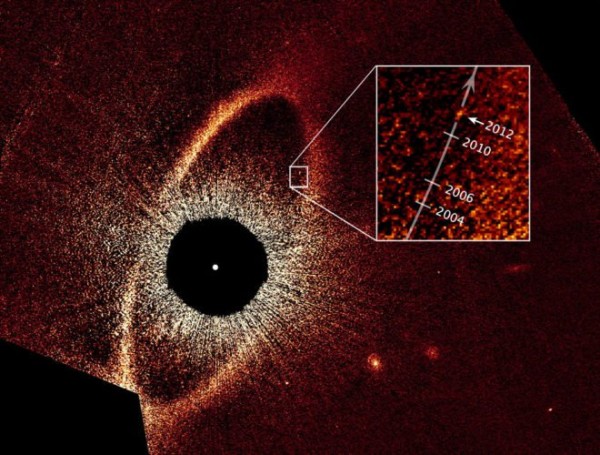By Ana Verayo, | January 30, 2017

This false-color composite image traces the motion of the planet Fomalhaut b, a world captured by direct imaging. (NASA, ESA, and P. Kalas, University of California, Berkeley and SETI Institute)
For the first time, astronomers have used direct imaging technique to observe four distant alien planets orbiting their star. This means that scientists were able to observe another stellar system similar to our solar system and have obtained direct visual evidence of these exoplanets.
Like Us on Facebook
These exoplanets are estimated to be 129 light years or 40 million years away from Earth in the Pegasus constellation, where this young star system is also known as HR8799. These exoplanets were first detected in 2008 along with the planet called Formalhaut b, which is considered to be the first exoplanet detected using a direct imaging technique.
Apart from this, these four planets also possess an almost precise ratio when it comes to their orbital periods with the other planetary bodies in the system, according to Jason Wang of NASA's Nexus for Exoplanet System Science program at University of California, Berkeley.
Scientists created a new video to demonstrate the motion of the planets while orbiting their star. The team utilized imagery obtained from the W.M. Keck Observatory in Hawaii that were taken in a span of several years. The video shows how the host star is blacked out to reveal light reflecting from the four exoplanets. The video does not show the full orbital period of all the planets since it can take decades and even hundreds of years to complete one orbital period.
The first direct imaging evidence of these four exoplanets was obtained by Christian Marois of the Herzberg Institute of Astrophysics' National Research Council in Canda back in 2008. Marois and his team captured HR 8799's first three planets known as HR 8799 b, c and d using this method. Fomalhaut b was then discovered by a team from the University of California, Berkeley using the same method as well.
Astronomers suggest that these are all gas giants slightly bigger than Jupiter with 10 times more mass. The team also realized that these planets were already detected by the Hubble Space Telescope using its Near Infrared Camera and Multi-Object Spectrometer (NICMOS) in 1998. However, when this new image processing method was installed, the system was not directly observed.
The fourth planet, HR 8799 e was apparently orbiting inside the other three exoplanets. It possesses an orbital period of 49 years. The rest of the planets take 112, 225 to 450 years to complete a full orbit of HR 8799.
-
Use of Coronavirus Pandemic Drones Raises Privacy Concerns: Drones Spread Fear, Local Officials Say

-
Coronavirus Hampers The Delivery Of Lockheed Martin F-35 Stealth Fighters For 2020

-
Instagram Speeds Up Plans to Add Account Memorialization Feature Due to COVID-19 Deaths

-
NASA: Perseverance Plans to Bring 'Mars Rock' to Earth in 2031

-
600 Dead And 3,000 In The Hospital as Iranians Believed Drinking High-Concentrations of Alcohol Can Cure The Coronavirus

-
600 Dead And 3,000 In The Hospital as Iranians Believed Drinking High-Concentrations of Alcohol Can Cure The Coronavirus

-
COVID-19: Doctors, Nurses Use Virtual Reality to Learn New Skills in Treating Coronavirus Patients







